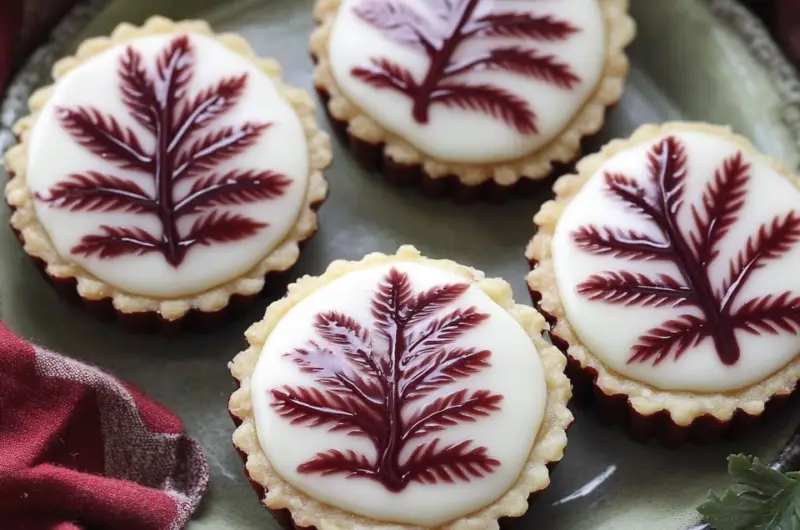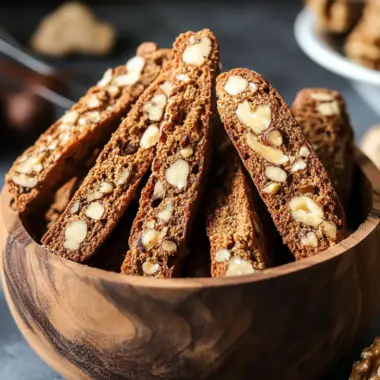The Scottish Fern Cake is a beautiful representation of traditional UK bakery finesse. This small tart consists of buttery shortcrust pastry filled with sweet jam, topped with a light sponge layer, and finished with a glossy almond-flavored icing. The true showstopper is the chocolate “fern” pattern delicately piped across the icing, which gives this little tart its name and iconic look. Common in Scottish bakeries for generations, fern cakes were once a staple of the afternoon tea table, offering elegance in a few bites. They are an absolute joy to serve at special events, or to enjoy as a nostalgic dessert with a cup of tea. Their classic design, light texture, and balanced sweetness make them a treat for both the eyes and the palate.
Full Recipe:
Ingredients:
-
1 1/4 cups all-purpose flour
-
1/4 teaspoon salt
-
1/2 cup (1 stick) unsalted butter, chilled and cut into cubes
-
2 to 3 tablespoons cold water
-
1/4 cup raspberry or strawberry jam
-
1/4 cup butter (softened)
-
1/4 cup sugar
-
1 egg
-
1/4 cup self-raising flour
-
1/4 teaspoon baking powder
Almond Icing:
-
1 cup powdered sugar
-
1/2 teaspoon almond extract
-
2 tablespoons water (or as needed)
Chocolate Icing for Fern Pattern:
-
1 tablespoon cocoa powder
-
1/2 cup powdered sugar
-
1 to 2 teaspoons water
Directions:
-
Prepare the pastry by combining the flour and salt. Cut in the cold butter until the mixture resembles breadcrumbs. Add cold water gradually until the dough forms.
-
Roll out the dough and cut into circles to fit tartlet tins. Press into tins and chill for 15 minutes.
-
Preheat oven to 375°F (190°C).
-
Place 1/2 teaspoon jam into each tart shell.
-
In a small bowl, cream butter and sugar, then beat in egg. Add self-raising flour and baking powder and mix gently.
-
Spoon batter over the jam in each tart shell, about 2/3 full.
-
Bake for 15–20 minutes until golden brown. Cool completely before icing.
-
Mix powdered sugar, almond extract, and water to make almond icing. Spread a thin layer over each cooled tart.
-
Mix cocoa, powdered sugar, and water to make chocolate icing. Pipe fern-like patterns on top of the almond icing using a piping bag or zip-lock with snipped corner.
-
Allow icing to set before serving.
Prep Time: 25 minutes | Cooking Time: 20 minutes | Total Time: 45 minutes
Kcal: 180 kcal | Servings: 12 cakes
Exploring the Classic Charm of Scottish Fern Cakes
Scottish Fern Cakes are one of the lesser-known but absolutely delightful gems in the traditional British baking repertoire. Often found in local Scottish bakeries and featured at afternoon teas, these charming little tartlets showcase the elegance of old-fashioned home baking. Featuring a tender shortcrust pastry base, a layer of sweet fruit jam, a light sponge filling, and a smooth almond icing topped with a chocolate fern design, these cakes are not only pleasing to the eye but also wonderfully flavorful.
Whether you’re a seasoned baker or simply love learning about heritage desserts, Fern Cakes are a recipe worth exploring. This article takes a deep dive into the background, appeal, variations, and significance of Fern Cakes in Scottish and British culture along with tips for making them at home and ideas for when to serve them.
The History and Heritage of Fern Cakes
Fern Cakes originated in the United Kingdom and became especially popular in Scotland. Their name comes from the chocolate decoration piped in a stylized fern leaf pattern across the top of the almond icing, which gives them their distinctive look. Though they are not as globally recognized as shortbread or scones, Fern Cakes hold a special place in the hearts of many who grew up in the UK, especially during the mid-20th century when they were common in bakery displays.
They were a typical offering in post-war British bakeries when ingredients became more available and celebratory baking made a strong comeback. Their petite size, elegant decoration, and rich layering made them ideal for afternoon teas, birthday tables, and church fetes.
Structure and Flavor Profile
At first glance, Fern Cakes resemble tiny works of art. But it’s their combination of textures and flavors that really make them unforgettable.
-
Pastry Base: The foundation of each Fern Cake is a buttery, crisp shortcrust pastry that holds its shape while offering a delicate crunch. It serves as the perfect contrast to the soft components above it.
-
Jam Layer: Nestled in the pastry shell is a small spoonful of raspberry or strawberry jam. This adds a burst of sweetness and fruitiness to the overall taste.
-
Sponge Filling: The sponge layer is soft and airy, rising just enough during baking to provide a light structure. It absorbs some of the jam’s flavor, adding complexity to each bite.
-
Almond Icing: The top of each tartlet is covered in a smooth, white icing, delicately flavored with almond extract. This layer is sweet, glossy, and luxurious.
-
Chocolate Fern Pattern: Finally, a chocolate icing is piped across the top in a fern-like design elegant and simple, yet deeply traditional.
Together, these components create a mini cake that is balanced, refined, and visually captivating.
The Importance of Presentation
One of the standout aspects of Scottish Fern Cakes is their visual appeal. They’re not simply delicious; they’re also beautiful. The contrast of the white icing with the dark chocolate fern is striking and unmistakable. This presentation gives the cakes a vintage bakery charm that’s rare in today’s era of mass-produced desserts.
Perfecting the fern pattern may take a bit of practice, but it’s worth the effort. The final result brings a sense of pride to any home baker and is guaranteed to impress guests at tea time or special events.
Occasions for Serving Fern Cakes
Fern Cakes are versatile and appropriate for a wide range of occasions:
-
Afternoon Tea: These cakes are tailor-made for a classic British-style tea service. Pair them with finger sandwiches, scones, and a pot of Earl Grey for an authentic experience.
-
Special Celebrations: Their elegant appearance makes them great for showers, weddings, or formal tea parties.
-
Holiday Baking: During festive seasons, Fern Cakes add a refined touch to cookie platters and dessert tables.
-
Gift Giving: Packaged in a box and tied with a ribbon, they make a beautiful homemade gift for friends or family.
-
Baking Competitions or Bake Sales: Their visual uniqueness and layered taste make them standout entries.
Tips for Success
While the recipe isn’t overly complicated, a few helpful tips can ensure bakery-worthy results:
-
Chill Your Pastry Dough: This helps prevent shrinking during baking and ensures a crisp, flaky texture.
-
Use Quality Jam: A thick, vibrant jam (like raspberry or strawberry) will hold its shape and flavor better during baking.
-
Don’t Overfill: The sponge layer will rise during baking, so fill the tart shells only two-thirds full to avoid overflow.
-
Let Cakes Cool Fully Before Icing: If the tarts are even slightly warm, the icing will run and lose its neat finish.
-
Practice the Fern Pattern: Use parchment paper to practice piping the design. A steady hand and even spacing create the most beautiful result.
Variations and Adaptations
One of the joys of baking Fern Cakes is the ability to adapt them to different tastes and dietary needs.
-
Flavor Variations: Try different jams like apricot, blackcurrant, or cherry for a twist on the classic flavor profile.
-
Nut-Free Version: Omit the almond extract or replace it with vanilla for those with nut allergies.
-
Vegan Fern Cakes: Use plant-based butter, a flax egg substitute, and a dairy-free icing to create a completely vegan version.
-
Gluten-Free Base: Substitute gluten-free flour blends for the shortcrust pastry to make it suitable for celiac or gluten-sensitive guests.
These variations allow the recipe to remain accessible while offering new experiences with each bake.
Why Fern Cakes Deserve a Comeback
In today’s food culture, which often favors convenience and flash over substance, Fern Cakes offer something refreshing: tradition, craftsmanship, and joy in small details. They aren’t just baked goods they’re edible nostalgia. Making Fern Cakes is a nod to simpler times, a connection to family memories, and a delightful way to honor the rituals of tea and conversation.
For food bloggers and home bakers looking to explore traditional recipes, Fern Cakes offer a unique opportunity to bring heritage back into the kitchen. They’re perfect for storytelling, photography, and personalization making them highly shareable on social media and deeply satisfying to prepare.
Conclusion:
Scottish Fern Cakes are more than just pretty pastries; they represent a time-honored baking tradition that values beauty, texture, and taste in equal measure. Their layered construction pastry, jam, sponge, almond icing, and chocolate shows that even small desserts can have a big impact. Whether you’re baking them for a tea party or showcasing them on your blog, these cakes embody a timeless charm that transcends trends.
Bringing Fern Cakes into your kitchen is a wonderful way to honor British culinary history while adding a personal, creative touch. Their elegance and taste are sure to win over anyone lucky enough to enjoy one.








